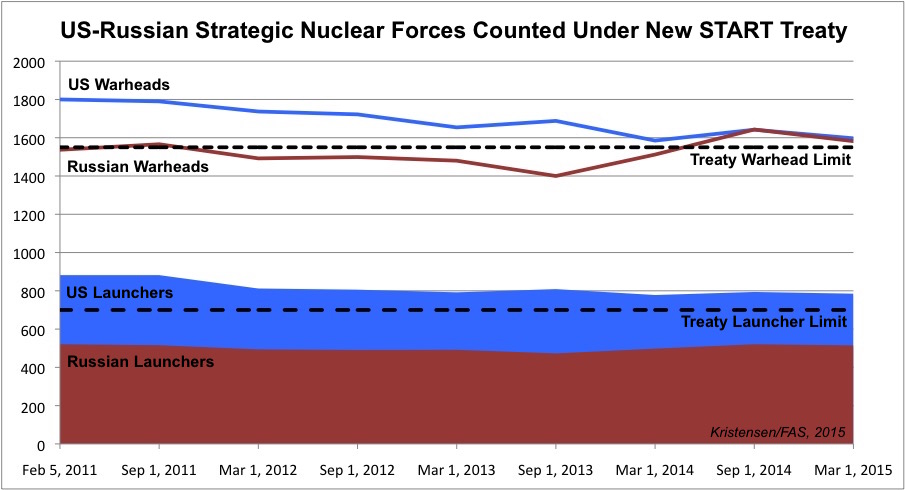
New START Treaty Count: Russia Dips Below US Again
By Hans M. Kristensen
Russian deployed strategic warheads counted by the New START Treaty once again slipped below the U.S. force level, according to the latest fact sheet released by the State Department.
The so-called aggregate numbers show that Russia as of March 1, 2015 deployed 1,582 warheads on 515 strategic launchers.
The U.S. count was 1,597 warheads on 785 launchers.
Back in September 2014, the Russian warhead count for the first time in the treaty’s history moved above the U.S. warhead count. The event caused U.S. defense hawks to say it showed Russia was increasing it nuclear arsenal and blamed the Obama administration. Russian news media gloated Russia had achieved “parity” with the United States for the first time.
Of course, none of that was true. The ups and downs in the aggregate data counts are fluctuations caused by launchers moving in an out of overhaul and new types being deployed while old types are being retired. The fact is that both Russia and the United States are slowly – very slowly – reducing their deployed forces to meet the treaty limits by February 2018.
New START Count, Not Total Arsenals
And no, the New START data does not show the total nuclear arsenals of Russia and the United States, only the portion of them that is counted by the treaty.
While New START counts 1,582 Russian deployed strategic warheads, the country’s total warhead inventory is much higher: an estimated 7,500 warheads, of which 4,500 are in the military stockpile (the rest are awaiting dismantlement).
The United States is listed with 1,597 deployed strategic warheads, but actually possess an estimated 7,100 warheads, of which about 4,760 are in the military stockpile (the rest are awaiting dismantlement).
The two countries only have to make minor adjustments to their forces to meet the treaty limit of 1,550 deployed strategic warheads by February 2018.
Launcher Disparity
The launchers (ballistic missiles and heavy bombers) are a different matter. Russia has been far below the treaty limit of 700 deployed launchers since before the treaty entered into effect in 2011. Despite the nuclear “build-up” alleged by some, Russia is currently counted as deploying 515 launchers – 185 launchers below the treaty limit.
In other words, Russia doesn’t have to reduce any more launchers under New START. In fact, it could deploy an additional 185 nuclear missiles over the next three years and still be in compliance with the treaty.
The United States is counted as deploying 785 launchers, 270 more than Russia. The U.S. has a surplus in all three legs of its strategic triad: bombers, ICBMs, and SLBMs. To get down to the 700 launchers, the U.S. Air Force will have to destroy empty ICBM silos, dismantle nuclear equipment from excess B-52H bombers, and the U.S. Navy will reduce the number of launch tubes on each ballistic missile submarine from 24 to 20.

In 2015 the U.S. Navy will begin reducing the number of missile tubes from 24 to 20 on each SSBN, three of which are seen in this July 2014 photo at Kitsap Naval Submarine Base at Bangor (WA). The image also shows construction underway of a second Trident Refit Facility (coordinates: 47.7469°, -122.7291°). Click image for full size,
Even when the treaty enters into force in 2018, a considerable launcher disparity will remain. The United States plans to have the full 700 deployed launchers. Russia’s plans are less certain but appear to involve fewer than 500 deployed launchers.
Russia is compensating for this disparity by transitioning to a posture with a greater share of the ICBM force consisting of MIRVed missiles on mobile launchers. This is bad for strategic stability because a smaller force with more warheads on mobile launchers would have to deploy earlier in a crisis to survive. Russia has already begun to lengthen the time mobile ICBM units deploy away from their garrisons.

Modernization of mobile ICBM garrison base at Nizhniy Tagil in the Sverdlovsk province in Central Russia. The garrison is upgrading from SS-25 to SS-27 Mod 2 (RS-24) (coordinates: 58.2289°, 60.6773°). Click image for full size.
It seems obvious that the United States and Russia will have to do more to cut excess capacity and reduce disparity in their nuclear arsenals.
A military depot in central Belarus has recently been upgraded with additional security perimeters and an access point that indicate it could be intended for housing Russian nuclear warheads for Belarus’ Russia-supplied Iskander missile launchers.
The Indian government announced yesterday that it had conducted the first flight test of its Agni-5 ballistic missile “with Multiple Independently Targetable Re-Entry Vehicle (MIRV) technology.
While many are rightly concerned about Russia’s development of new nuclear-capable systems, fears of substantial nuclear increase may be overblown.
Despite modernization of Russian nuclear forces and warnings about an increase of especially shorter-range non-strategic warheads, we do not yet see such an increase as far as open sources indicate.